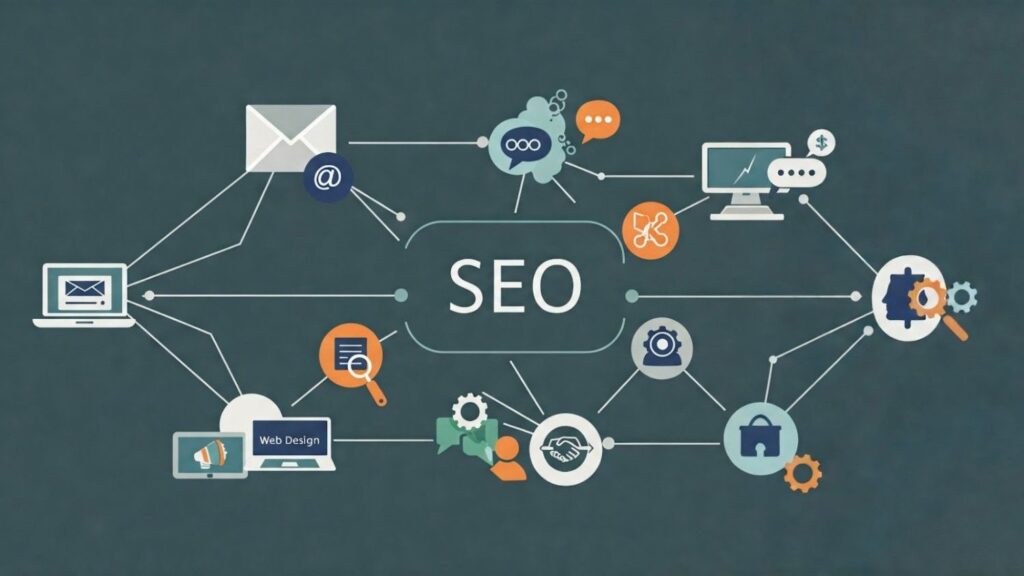Marketing channels have never been more abundant or more disconnected. As platforms multiply and user journeys grow more complex, businesses that rely on isolated campaigns are losing ground. Consumers don’t engage with just one touchpoint; they move fluidly between social ads, emails, search results, and mobile apps, often within minutes.
The problem? Many brands still treat these channels as separate efforts, resulting in inconsistent messaging, redundant spending, and missed opportunities to build real connections.
In 2025, dominating the digital landscape means marketing in sync. Success lies in aligning every touchpoint into a seamless, user-focused journey. When every channel works together, the result is better engagement and smarter, more efficient growth.
What Is Cross-Channel Marketing and Why It Matters in 2025
Cross-channel marketing creates a cohesive customer experience across multiple platforms, channels, and devices. Unlike multi-channel marketing, which uses various channels independently, cross-channel strategies ensure those channels work together in a connected, consistent way.
The key difference is integration.
In a multi-channel setup, a brand might send emails, run ads, and post on social media, but each channel tells a different story. For example, an email might promote a sale, while an ad highlights a new product, and the website pushes something else entirely.
With cross-channel marketing, all touchpoints work together. A customer who clicks an ad sees matching messaging on the website, gets a follow-up email that continues the offer, and later sees a reminder on social media. The experience feels connected and intentional.
The takeaway is simple: brands that deliver consistent, cross-channel experiences are better positioned to capture attention, build trust, and turn interest into action.
Strategies for Cross-Channel Marketing Success in 2025
Building an effective cross-channel marketing strategy is about showing up consistently and intentionally at every touchpoint. Below are key strategies businesses can apply to create meaningful, connected experiences that resonate in 2025.
Unify Your Brand Message Across All Channels
When someone interacts with your business, whether it’s through a social ad, email, or your website, it should always feel like the same brand is speaking to them. That means the message, look, and voice should match wherever they find you.
Strengthen Your Online Authority with The Ad Firm
- SEO: Build a formidable online presence with SEO strategies designed for maximum impact.
- Web Design: Create a website that not only looks great but also performs well across all devices.
- Digital PR: Manage your online reputation and enhance visibility with strategic digital public relations.
Here’s what that looks like:
- Visual consistency – Use the same colors, fonts, logo, and overall style everywhere: on your website, social media, ads, and emails.
- Consistent voice – Whether it’s a casual Instagram caption or a formal service page, your tone should sound like it’s coming from the same brand personality.
- Clear calls to action – Each message should point users in the same direction, with no conflicting offers or mixed goals.
When your messaging is inconsistent across platforms, it causes confusion. Customers might see one offer in an ad and a different message on your website or find your emails using different visuals than your social channels. These gaps can make your brand feel disorganized or unreliable.
Inconsistent messaging can lead to:
- Distrust from users who aren’t sure what your brand stands for
- Missed opportunities because users feel disconnected or unsure
- Lower results from marketing campaigns that don’t support one another
How to keep your messaging aligned:
- Create a brand messaging guide – This document defines your voice, tone, visuals, and key talking points so everyone on your team uses the same approach.
- Plan campaigns together – Use shared calendars so marketing, design, and content teams are aligned on what’s being promoted and when.
- Review your content regularly – Look for places where the message, offer, or tone doesn’t match, and fix inconsistencies as they come up.
People start to recognize your brand faster when your message is consistent everywhere. That familiarity builds trust, and trust leads to more clicks, more conversions, and more substantial long-term growth.
Use Data to Deliver Personalized Experiences
Customers don’t want to feel like just another name on a list. In 2025, they expect businesses to understand their interests, needs, and behaviors and respond with content that reflects that. This is where personalization comes in.
Personalization means adjusting your marketing content based on what someone has already done or shown interest in. For example, someone browsing a specific product on your website might later receive an email or see an ad highlighting that exact product.
Why it works:
Generic marketing is easy to ignore. When a message feels tailored to the customer, they are more likely to pay attention. Personalization makes your marketing feel more helpful and less like noise.
Transform Your Online Strategy with The Ad Firm
- SEO: Achieve top search rankings and outpace your competitors with our expert SEO techniques.
- Paid Ads: Leverage cutting-edge ad strategies to maximize return on investment and increase conversions.
- Digital PR: Manage your brand’s reputation and enhance public perception with our tailored digital PR services.
How to use data to personalize experiences:
- Start by tracking behavior. Tools like Google Analytics or customer databases (CRMs) can show what pages people visit, which products they view, and what actions they take on your website or in your emails.
- Use that behavior to guide your content. For example, show recommended products based on past views or display different headlines on landing pages depending on what the visitor clicked on before arriving.
- Send follow-up messages based on actions. If someone adds an item to their cart but doesn’t check out, follow up with a reminder or an offer.
The more relevant your messaging feels, the more likely your audience will stay engaged. Personalization, when done right, makes your communication feel timely and valuable instead of repetitive or random.
Segment Your Audience for More Relevant Campaigns
Not all of your customers are looking for the same thing. Some are brand new and just exploring. Others are ready to make a decision. Trying to speak to all of them with the same message is a common mistake.
This is where segmentation comes into play. Segmentation is the process of grouping your audience into smaller categories based on their common characteristics. This might include their shopping behavior, interests, or stage in the buying journey.
When people receive messages that match their current needs or interests, they are much more likely to click, respond, or convert. Instead of guessing what works, segmentation helps you focus your message on what matters most to each group.
How to apply it:
- Group your audience by behavior. For example, separate returning customers from first-time visitors. You can also group by how often someone engages with your emails or website.
- Use ad platforms to manage audiences. Platforms like Meta or Google Ads allow you to create audience groups based on demographics, behaviors, or website activity.
- Match your content to each group’s needs. Someone new to your brand might need educational content. A repeat buyer might be looking for exclusive offers.
Segmentation is a smarter way to communicate. When you send the right message to the right group, your marketing becomes more relevant, more personal, and more effective.
Automate Campaigns with AI and Machine Learning
Marketing used to rely heavily on manual effort. Today, artificial intelligence (AI) and machine learning have changed how teams manage campaigns, making it easier to respond to customer actions in real time and at scale.
Enhance Your Brand Visibility with The Ad Firm
- SEO: Enhance your online presence with our advanced SEO tactics designed for long-term success.
- Content Marketing: Tell your brand’s story through compelling content that engages and retains customers.
- Web Design: Design visually appealing and user-friendly websites that stand out in your industry.
When a potential customer visits your site, clicks an ad, or adds an item to their cart, they show intent. Acting on that intent quickly makes a difference. AI tools help businesses react in the moment, sending the right message without delay.
What this looks like in action:
- A welcome email is sent automatically after someone subscribes to your list.
- A user sees product suggestions based on what they browsed the last time they visited.
- Ad content changes based on previous actions, like whether someone viewed a page or added an item to their cart.
How to get started with AI-driven automation:
- Choose the right platform. Tools like HubSpot, Klaviyo, and Mailchimp offer built-in automation features for email marketing. Google Ads and Meta also provide automation options for ad delivery based on user behavior.
- Set up behavior triggers. Decide what actions you want to respond to, such as signing up for a newsletter, clicking a product, or visiting a key page. These can trigger follow-up emails, reminders, or personalized ads.
- Start small and test. Begin with one or two automated workflows, like a welcome series or a product reminder. Monitor how they perform and adjust over time.
- Use templates if needed. Most platforms offer ready-made automation flows you can customize, so you don’t have to build everything from scratch.
AI allows you to apply your strategy more effectively across every touchpoint.
Optimize the Mobile Experience Across Channels
Most users check emails, view ads, or browse websites from their phones. If that mobile experience is clunky or hard to navigate, it will affect results across your entire marketing campaign.Even if someone completes a purchase on a laptop, chances are they interacted with your brand on mobile first. That means every mobile experience matters, from how fast your page loads to how easy it is to read and click.
How to improve the mobile experience:
- Design with mobile in mind from the start. This includes using larger buttons, clear fonts, and layouts that scroll quickly.
- Test across multiple devices. What works on an iPhone may look different on an Android. Regular testing helps catch layout issues before they affect your audience.
- Support the journey with mobile tools. SMS messages, push notifications, or mobile-friendly forms can help re-engage users after their first visit.
Mobile is often the starting point of the user journey. When it works well, it keeps users engaged and helps other channels perform better too.
Elevate Your Market Presence with The Ad Firm
- SEO: Boost your search engine visibility and supercharge your sales figures with strategic SEO.
- PPC: Target and capture your ideal customers through highly optimized PPC campaigns.
- Social Media: Engage effectively with your audience and build brand loyalty through targeted social media strategies.
Leverage Advanced Tech for Immersive Experiences
Today’s audiences are harder to impress and even harder to keep engaged. To stand out in 2025, brands are leaning into technology that grabs attention and creates memorable experiences.
Augmented reality (AR), virtual reality (VR), interactive content, and chat tools help transform passive browsing into active engagement. Instead of just reading about a product, customers can explore it, try it virtually, or interact with it directly on screen.
Ways to create more immersive experiences:
- Use AR for product previews. Let customers see how furniture fits in their space or try on glasses from their phone before buying.
- Add chatbots for real-time guidance. Chatbots can help users navigate between channels, answer FAQs, or connect them to a human when needed.
- Connect offline to online. Tools like QR codes or smart in-store displays allow shoppers to instantly explore product videos, sign up for offers, or access exclusive content.
This kind of tech drives more profound engagement, builds confidence in buying decisions, and sets your brand apart from competitors.
Track Performance and Use Analytics to Iterate
No marketing strategy is complete without a way to measure performance. Whether you’re running email campaigns, paid ads, or SEO services, tracking what works (and what doesn’t) is key to making smarter decisions and improving results over time.With so many platforms involved, it’s easy to lose sight of where your results are really coming from. Analytics helps you understand how each channel contributes to the full user journey.
How to stay data-driven:
- Decide what success looks like for each channel. For example, when you send marketing emails, you might track how many people open them or click a link inside. For paid ads, you can measure how much you spend to get one person to click or make a purchase.
- Use tracking tools to follow the customer journey. Tools like Google Analytics (GA4), your customer contact database, or built-in reports from ad platforms can show you how people first found your business, what pages they looked at, and whether they eventually became a customers.
- Keep improving with small tests. Try running two versions of an email, ad, or landing page to see which performs better. You can then use what you learn to improve future campaigns.
Boost Your Business Growth with The Ad Firm
- PPC: Optimize your ad spends with our tailored PPC campaigns that promise higher conversions.
- Web Development: Develop a robust, scalable website optimized for user experience and conversions.
- Email Marketing: Engage your audience with personalized email marketing strategies designed for maximum impact.
Good data takes the guesswork out of marketing and turns your campaigns into an engine for continuous growth.
At The Ad Firm, we help businesses bring their marketing channels together under one strategy that works. From planning and design to campaign execution and analytics, we ensure every piece supports the bigger picture. Contact The Ad Firm for a custom strategy built for long-term growth.






